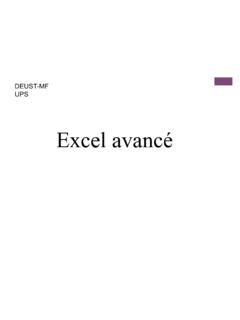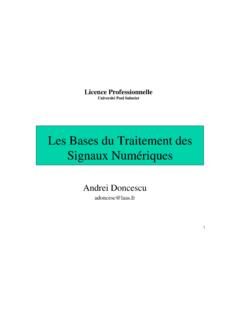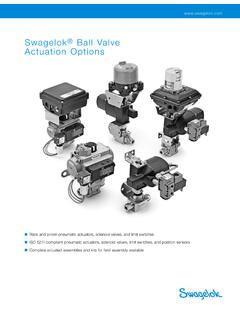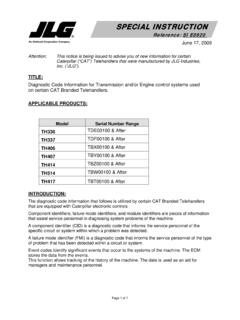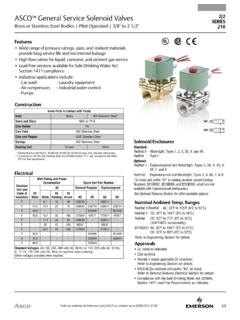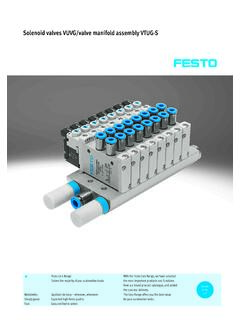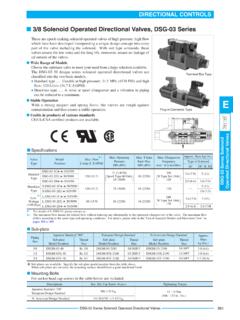Transcription of DC motors: dynamic model and control techniques Contents
1 DCmotors:dynamicmodelandcontroltechnique sLucaZaccarianContents1 eldandconductors.. forcein a rotatingcoil.. EMFe ect..52 Thebasicequationsof .. motors.. diagramof theDCmotor..93 Statorvoltagecontrolwithconstant ..114 Statorvoltagecontrolwithconstant ..145 Armature-Current .. eldandconductorsAmagnetic eldis generatedby a owingcurrent: it is in particularexperiencedintheneighborhood of a ectof a magnetic eldmay be experimented,forinstance,by positioninga magnetcloseto a wirewherea current is owing;whatcanbeobserved is thatthemagnetexperiencesa force,which is dueto themagnetic eldgeneratedby thecurrent owingin themagnetis moved aroundthewire,theforcechangesdependingon thepositionsassumedby particular,it canbe observedthatthemagnetic elddecreasesas thedistancefromthewireincreasesandincrea sesas thecurrent experiment aimsto verifythata owingcurrent indeedgeneratesa vector eld~B.
2 This eldmay be thought of as thesumof in nitecontributionsd~Bdueto allthein nitesimalsegments of wired~l, wherethecurrenti segment inducesamagnetic eldat any point in particular,theBiotandSavartlawstatesthat ,if~ris thevectorconnectingthewiresegmentd~lto a genericpointpin thespace,thecontributiond~Bof themagnetic eldin thepointpdueto thesegmentd~lis givenbyd~B=id~l ~rjrj3;(1)wherethesymbol~denotesthatthec onsideredquantity is a vectorof 3andthesymbol (1)providesa tool forcomputingthemagnetic eldassociatedto any conductorwherea current is particular,by suitablyintegratingit forthecaseof a solenoid ,it turnsoutthat,if thecornere ectsareneglected(namely, thesolenoidis longenough),the eldinsidethewindingsis constant andparalleltotheaxisof thesolenoid,anditsmagnitudeis givenby [6, p.]
3 136]j~Bj= lN i;(2)wherelis thelengthof thesolenoid, is themagneticpermeability of thedielectricinsidethesolenoid,Nis thenumber of turnsof thewire(seeFigure1).Considernow a surfaceSlocatedin a magnetic eld~B; themagnetic ux, or ux owingthroughthesurfaceis de nedastheintegralalongthesurfaceof thenormalcomponent of themagnetic eld: :=ZS~B ~n dS;where~nis theperpendicularto particular,if a uniformmagnetic eld~Bapproachesa atsurfacewithanangleofincidence andtheareaof thesurfaceisA, then =j~BjAcos :(3)1 Figure1: Themagnetic eldin theneighborhood of a solenoidwherea currenti equation(2).Sincethecrosssectionof thesolenoidhasconstant area,the ux owingthrougha genericsurfacenormalto thesolenoidaxisis constant areaof thecrosssectionof thesolenoid,sincethemagnetic eldis parallelto thesolenoidaxis( , = 0),the uxmay be computedsubstitutingequation(2)in equation(3): =K0N i;(4)whereK0:= forcein a rotatingcoilOnceunderstood thata movingchargegeneratesa magnetic eld,whataboutif a movingchargepassesthroughan exogenousmagnetic eld?
4 TheLorentz forceequationis a goodstartingpoint to understandthemechanicalaspectsof forceis theforceexperiencedby a movingchargein an electromagnetic ~Edenotestheelectric eld,~Bdenotesthemagnetic eld,qis a chargemovingwithaspeed~vin thespace,thenthechargeexperiencesa forcegivenby~F=q(~E+~v ~B):(5)Now, considera wirewherea uniformcurrentiis eldtobe zero(thisis thecaseof a DCmotor),withreferenceto thequantity of chargedqfoundin anin nitesimalsectiond~`of thewire,theforcein equation(5)may be computedas afunctionofi:d~F=dq ~v ~B=dqd~`dt ~B=dqdtd~` ~B=i d~` ~B:2liiB FFigure2: Forceexperiencedby a current-carryingconductorlocatedin a uniformmagnetic turnsoutthat,if denotestheangleof incidencebetweenthemagnetic eldandastraight wireof lengthl, thenthemagnitudeof theforce~Fis givenbyj~Fj=i lj~Bjsin ;(6)and~Fis orientedontheperpendicularto theplanespannedby themagnetic eldandthewirefollowingtheright-hand-scre wrule(seeFigure2).
5 Now, onthebasisof equation(6),considera rigidrectangularcoilconstitutedby a singlewirewherea currenti ows,suitablylocatedin anuniformexogenousmagnetic seenfromFigure3;1iflis thelengthof thewireperpendicularto themagnetic eld,thentwo forcesareappliedto of equation(6)is 2(dependingonwhich sideof thecoilis considered),thenit turnsoutthatthemagnitudesof thetwoforcesarethesame:j~Fj=j~Bji l:(7)Sincethecoilis square,thecurrenti owsin oppositedirectionsonthetwo sidesofthecoil;thus,thetwo forcesFgeneratea torqueTexertedat thecenterof thecoilthatis dependent ontheangularposition of thecoilwithrespectto themagnetic ,if thelengthof anedgeof thesquareisd, thenT= 2j~Fjd2sin =j~Fjdsin ;(8)whence,takinginto account equation(7),equation(8)yieldsT=j~Fjdsin =j~Bji l dsin :(9)1 Asusual,a dot meansthatthe owingcurrent is exitingthepage,whilea cross meansthatthecurrent is d=2 BFigure3: Torqueexperiencedby a coilin a uniformmagnetic 2 2 TFigure4: Pro leof thetorqueTexperiencedby thecoilin a magnetic eld,as therotationangle equation(9)andnoticethatthetorquehighlyd ependsontherotorcoilangularposition.
6 Imaginethatthecoilis in therotorof a motor ;thentheresultingtorqueis highlydependent onthemotorposition;moreover,if noloadtorqueis present, themotorkeepsturningclockwiseandcounter- clockwise;as a matterof fact,if thecoilturnsof anangle , thetorqueexertedhasthesameamplitudebutop positesign(seeFigure4).Sincethegoalis to have themotorto exerta constant torqueforany position , thesolutionadoptedis to insertontherotorshafta commutatorconstitutedby two segmentsconnectedto therotorwindingsandbrushesthatslidebetwe enthesegments as therotorturns(seeFigure5).Insuch a con guration,thesignof thecurrent owingin thecoilchangesat each halfrevolutionof themotor;thus,if thesegments areproperlypositionedwithrespecttothecoi lposition,thetorquepro leof Figure4 willbe suitablyinvertedduringhalfrevolution(see Figure5).
7 Now, oncethissolutionis adopted,althoughthetorquehasalways thesamesign,stillitis highlydependent ontherotorposition;theobvioussolutionto thisproblemis to increasethenumber of coilsin therotorandthesegments of thecommutator,connectingeach pairofoppositesegments to a coilin such a way thatwhenthebrushesactivatethatcoil,thero torangleis = 2( , themaximumtorqueposition).It turnsoutthat,ifNindependent4 T 0B 0iFigure5: Torqueexertedby themotor,whena two segments commutatoris ,thecommutatorwillhave 2 Nsegments andthetorquepro lewillbe constitutedby 2 Nhalfsinusoids(relatedto thetorquesTiexperiencedby eachcoil)overlappedin onesingleperiod (seeFigure6, where cdenotesa genericcommutationangle).In such a way thetorqueripplemay be decreasedas much as neededby increasingNandtheresidualripplemay be assumedto be lteredby themechanicalsystem,so thattheresultingtorquemay be approximatedasT=i l dj~Bj:(10)Finally, consideringthat,by equation(3),the ux owingthroughtherotoris pro-portionaltoj~Bj(notethattheangle in equation(3)is equalto =2; as a matterof factthe uxis assumedto be owingstraight insidethemotor),it turnsoutT=K i;(11)whereK :=l d= EMFe ectIn Figure4, therotorconductorscarrycurrent suppliedfromanexternalsourceandarelocate din anexogenousmagnetic eld.
8 Whence,forcesareexperiencedby thecoilandatorqueis ,dueto therotationof thecoil,theconductorsthemselves cutthemagnetic ux,thus generatinganelectro-motive force( , aninducedvoltagein therotorwindings)whosemagnitudemay be computedby meansof theFaraday'slaw of induction. Thislaw statesthatif thereis a variationof the ux c owingin theinternalsurfaceof a closedwire,thenanelectro-motive forceeis inducedin thewire,accordingto:e= d cdt:(12)5Ti T c c c c c c c c cFigure6: Torqueexertedby themotor,whena multiplesegments commutatoris thisparticularcase,noticethatthe ux owingin thecoilis givenby equation(3)substituting withtheangle (t) of themotorandAwiththeareaof theinternalsurfaceof ,computingthederivative in equation(12),theback electro-motiveforceor,moreeasily, theback EMFmay be computedase= ddt(j~BjAcos (t))=j~BjA_ (t) sin (t)=j~BjA !
9 (t) sin (t);where!:=d (t)dtdenotestheangularspeedof ,duetothepresenceof thecommutator,thecoilalwaysoperatesin aneighborhood theposition = =2, thensin (t) 1 andtheback EMFmay be writtenase=j~BjA !(t).Finally, similarlyto thecasestudiedin equations(10)and(11),theback EMFmay beexpressedas a functionof the ux ,andit canbe veri edeasilythate=K !;(13)whereK is thesameconstant as theonein equation(11).2 Thebasicequationsof theDCmotorThesetof equationsherereported,constitutesa modelof theDCmotor,which may6be representedas a thismodel,withrespectto a realmotorare1. theassumptionthatthemagneticcircuitis linear(such an assumptionis approximate,sincethemetalpartsarenotperf ectlysmoothandthereis some uxdispersioninsidethemotor,moreover,duet o saturationof themetal,equation(4)does notholdforhighvaluesofi);2.
10 Theassumptionthatthemechanicalfrictionis onlylinearin themotorspeed;namely,onlyviscousfriction is assumedto be present in themotor(such anassumptionisapproximatesinceCoulomb frictionis usuallyexperiencedin motors). ,in a DCmotor,themagnetic uxisgeneratedby electricalpower is transformedin mechanicalpower istheoneexplainedin ,theactualimplementationsof thisresultarevarious,as amatterof fact,sincethemagnetic eldBarisesfromthestatorcoils,notonlyther otorcoilsmay rotatewithrespectto thestator,butalsothestatorsupplymay rotate(inanelectricalsense)by increasingthenumber of coilsandby a ,a simplemodel,which appliestotheabove cases(providedpropertransformationsarepe rformedonthesystemvariables)willbe themotorwillbe assumedto have a singlecoilcharacterizedby aninduc-tanceLedueto thewindingsanda resistanceRedueto dispersionsin theconductor(seeFigure7).
